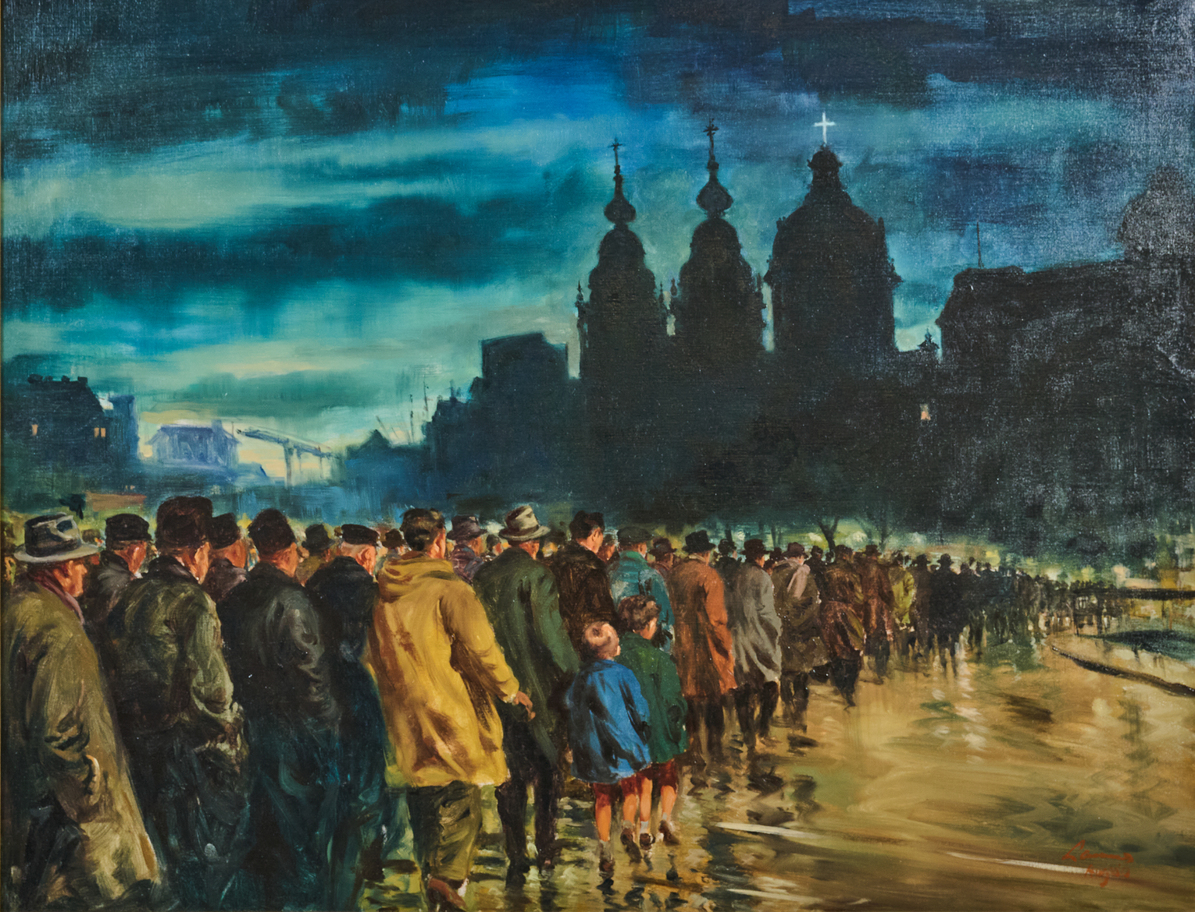Anyone looking at Frans Lammers' paintings might think that the Silent Procession is primarily a religious procession for (young) men. That image is incorrect. Read here how women have walked the procession route from the very beginning.
Location
Stille Omgang
Prins Hendrikkade
Type
Religious place of assembly
Religious community
Roman Catholic Church
Object
Painting of the Silent Procession at the Nicolaasbasiliek, Frans Lammers 1955
Maker and date
Frans Lammers
1955
Visit
Painting is in the museum's depot
In 1880, Joseph Lousbergh and Carel Elsenburg came into possession of a document in which the old route of the medieval Miracle Procession was described in detail. They then decided together to walk the original procession route in prayer and meditation on the Sunday after the feast of the Miracle in the early morning, concluding with a mass in the Begijnhofkapel. Together with friends and acquaintances, they walked this route for the first time in 1881. But soon others joined in and a tradition was born that Catholics from all over the country came to.
The rector of the Begijnhof, Mgr. B.H. Klönne, already noted in 1884: ‘On Sunday … there was a procession through the city very early in the morning, mainly by young gentlemen and in the afternoon around one o’clock by young ladies.’ However, there were not yet hundreds of people walking the route. In 1886, Klönne noted that, after some advertising, more than sixty people – men and women – had participated in the ‘stillen omgang’ in the early morning. The term ‘stille omgang’ (silent procession) was used for the first time, but from that moment on it would be the standard designation for the night walk.
The advertising made the Stille Omgang more widely known and its popularity increased rapidly. In 1888, around six hundred people took part in the night walk and the sung mass that followed. This did not go unnoticed in the city and also caused annoyance among some Amsterdam residents. Don’t forget that there was still a ban on processions at that time. Clear anti-Catholic sentiments also played a role now that the Catholic Church was experiencing a revival. In order to keep the numbers manageable, women were asked not to walk at night but during the day, in small groups. This measure, intended as a practical measure, soon became standard practice and, wrongly, even a mandatory requirement. It takes until the sixties of the previous century before women and men walk the Stille Omgang together again. It is also in the post-war years that the Stille Omgang reaches its greatest flourishing. After that, the number of pilgrims decreases to remain fairly stable in the last years around 5000 participants.
August den Hollander
Professor of Religious Heritage
Luna Hagen
Student minor Religieus erfgoed in Amsterdam (Vrije Universiteit/Reinwardt Academie), 2022
Last edited
March 11, 2025
Frans Lammers. Nachtelijke ‘Stille Omgang’ bij de Sint Nicolaaskerk, 1955. Oil on canvas, 72 cm x 93 cm. Amsterdam, Ons’ Lieve Heer op Solder. Fotografie Robert Westera.
Frans Lammers. De Stille Omgang bij de Begijnhofkapel, 1959. Oil on canvas, 37,2 cm x 28,2 cm. Amsterdam, Ons’ Lieve Heer op Solder.Fotografie Robert Westera.
Raedts, P. Amsterdam: de Heilige Stede, 1345. Ommegangen en mirakelen', in W. Blockmans & H. Pleij(red.), Plaatsen van herinnering. Nederland van prehistorie tot Beeldenstorm, Amsterdam: Bert Bakker 2007. 290-301.
Online sources
Het verhaal van een honderdjarige
Last visited 11-03-2025






